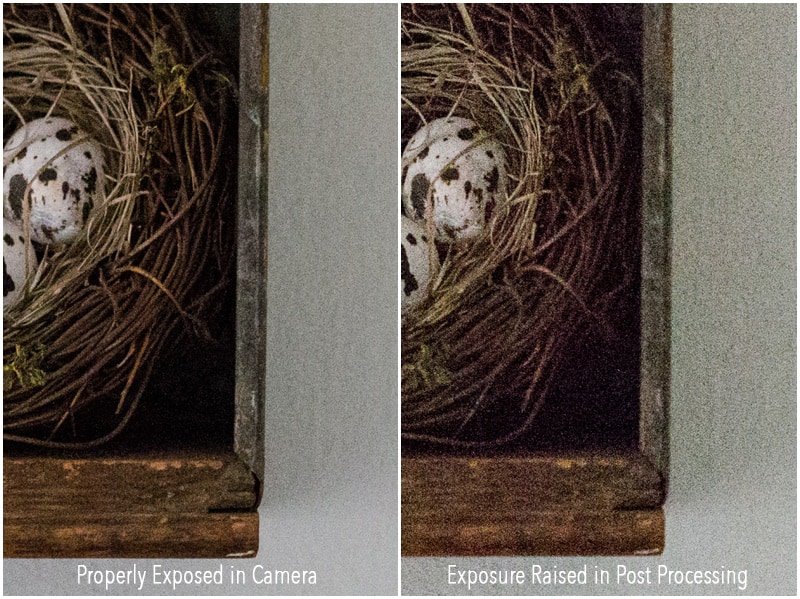Do Older Cameras Have More Noise
Have you seen the term "noise" thrown around and wondered what exactly it is? Or mayhap y'all've noticed that some of your images aren't as crisp and articulate as you desire them to be, and almost accept a grainy appearance to them. Digital noise could exist the reason. By understanding what noise is and how it makes its style into your photographs, y'all tin take a few steps to avert it. And for those times when noise is unavoidable, we volition talk over some means to right it as well.
What is Dissonance?
Simply similar with sound, where noise refers to auditory disruptions, in photography, the term digital racket refers to visual distortion. Noise looks like tiny colored pixels or specks in your photograph, and sometimes resembles the grain that yous may see in picture photography. You volition likely detect noise more in photographs taken in low light situations. Noise can distort the visual detail of your photo, making it something that photographers endeavour to avoid. Several factors can affect the level of noise, including sensor size, college ISO settings, and long exposures, to proper noun a few.
How to Avoid Dissonance
If you lot are noticing a lot of dissonance in your photos, the first step is to determine what the contributing factor(due south) may exist. Once you tin can pinpoint where the noise is coming from, yous tin have steps to avert it. These are a few ways you lot can forbid big amounts of noise:
Lower ISO: Higher ISOs produce more noise, then information technology helps to shoot with the everyman ISO that you lot tin can while still maintaining proper exposure. Different DSLR cameras will vary in their ability to shoot at loftier ISOs without noise, and this is largely due to the camera's sensor (more on that below). The examples below show how the ISO impacts the corporeality of racket in an epitome. All of these images were shot with a Canon 6D. In the prototype shot at ISO 16000, the noise is essentially more visible when zooming in on the paradigm. You tin can run across that when the ISO is lowered to fifty-fifty 4000, at that place is an increase in the clarity of detail and the amount of dissonance is reduced. This becomes even more evident at ISO 2500.

I endeavor to enhance my ISO as a last resort for obtaining proper exposure. When I am shooting in depression-light situations and I need to get more calorie-free to my photographic camera'south sensor in club to properly expose an image, I volition always endeavour to open up my aperture first. If I yet need more than light, I boring my shutter speed downward to the minimum acceptable speed for the subject area I am photographing before increasing my ISO.
Larger Sensor: The size of a camera'south sensor plays a large function in the final image quality, including the level of dissonance in a photograph. Your photographic camera's sensor contains millions of "photosites," or low-cal-sensitive spots used to gather and record the information brought in through your camera's lens. Naturally, a larger sensor has the ability to gather more information. Therefore, the larger your camera's sensor, the better the paradigm quality. The departure in sensor size is one main reason why crop-sensor cameras produce images with more noise at increased ISOs than total-frame cameras. You can read more than most crop vs. full frame cameras here.
Expose Properly: When a photograph is exposed properly, there is less introduction of racket into the prototype. By getting your exposure correct in camera, you can avoid unnecessary noise. Encounter the comparison below. The epitome on the left was exposed properly in camera, and the image on the correct was originally underexposed, with the exposure being increased in Lightroom. Both of the images were shot at ISO 12800.Notice the substantial difference in the corporeality of racket in the image on the right. Exposing your images properly in camera goes a long way to preventing undesirable dissonance.

Tin Noise be Corrected?
Some cameras have built in noise reduction, which could be helpful, but is non a characteristic I use since racket reduction is and then uncomplicated in post-processing. In Lightroom'due south Develop Module, you tin can reduce the advent of noise in your images past using the Luminance slider in the Details panel. Simply move the slider to the right to reduce racket, using circumspection to not accept it too far. Too much dissonance reduction can result in loss of detail in your epitome, giving them a "plastic" look, so be certain to keep an centre on the overall advent of your image when using this feature.

The next fourth dimension you're dealing with digital noise in your images, check to run across if 1 of the tips above tin can aid y'all to forestall it or right it, then that you can have crisp, clean images, without the nuisance of the distortion that noise brings to your images.
Source: https://www.colesclassroom.com/digital-noise-correct/
Posted by: gonzalessiquene.blogspot.com

0 Response to "Do Older Cameras Have More Noise"
Post a Comment